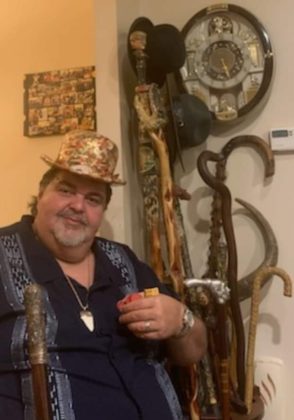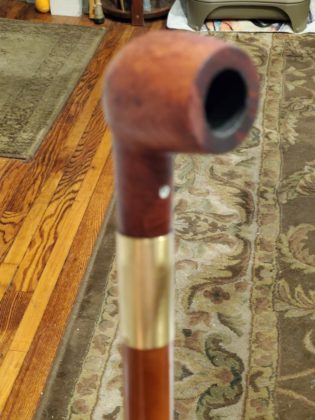Poker Chips, Umbrellas and Violins: All in a Cane’s Work
“Speak softly and carry a big stick” may be something that American president Theodore Roosevelt once said, but he wasn’t writing to Al Capone nor using his cane. Gus Tsiavos, however, might have a different story when it comes to sticks and canes. Gus is a master craftsman in the art of “caning”. It’s serious business. Waking up at 4am, at the crack of dawn, he heads to his workshop to break apart and crack open a few legs. No crime is being committed here, but who knew that Al Capone carried a cane, and inside that cane, he carried his poker chips and gambling loot too? Gus will tell you that you never know what you are going to find inside canes that get sold in various places, like eBay, flea markets, and antique stores.

Gus Tsiavos wearing a hat he made with over 5000 cigar labels using a glue gun and lacquer and holding the Al Capone cane
Gus collects canes, not just any canes, but canes that may come with a history. He has an impressive and extensive collection – about 550 canes to be exact. He takes them apart, rebuilds them, and even redesigns them. He explained that, in the past, one needed permission to carry a cane. Doctors often hid medicine inside canes when they went to visit sick patients. It is reputed that Byzantine monks hid silk worms in their canes and smuggled them out of China which had the monopoly of silk, until then. Gangsters, like Al Capone, knew they were a great way to hide your earnings during the era of prohibition and illegal gambling. This particular Al Capone cane, of which Gus is the proud owner, was gifted to the infamous gangster by the prestigious NYC Stork Club back in 1929. When Gus got a hold of the cane, it came complete with the original ivory chips at the bottom.

The Al Capone cane
Other uses for canes included umbrellas, which made for a very convenient two-in one device that protected you from both the rain and a slip and fall. It must be no coincidence then that the handles of umbrellas often resemble a cane.

The canes Gus collects come from different parts of the world. “People often don’t realize that these canes may be carrying objects in them,” he explains. One of the canes he stumbled upon was made out of a horn. The base was very dirty and it had to be cleaned. It took 3.5 months just to prepare the cane to be opened. Once he was able to open it, he found a samurai sword inside.

Apart from opening them, which is its own process, he has a creative eye for redesigning them as he rebuilds them. He had a cane from Russia to which he connected a horn from Africa. Another cane he redesigned was made out of bamboo and belonged to a priest, which he fashioned after a lambada, a type of Greek Orthodox candle used for certain festive occasions like Easter. He uses an epoxy resin, which is a type of durable adhesive that can take anywhere from 5 minutes to two hours to harden. In this case, he had to keep turning the cane for two hours to get it to harden. He also ads coffee grinds and cigar ash to the mixture. Gus uses the same type of epoxy used for golf clubs.

One of the most sought after canes by cane collectors is the violin cane. If it belonged to a famous violinist, it’ safe to assume you would have struck a very big chord here, so the next time you are at that antique store or flea market and come across a cane, maybe grandma hid her millions in it.

When Gus is not partaking in his cane hobby, which we hope we will see on exhibit someday, he also extends a hand to other arts and crafts hobbies. It is no secret that Gus is a huge cigar aficionado. What to do with all those cigar labels he collected over the years? He took an old hat from the 1920s and put over 5000 cigar labels using a glue gun and lacquer. Not sure if he’s ever been caught wearing it, but Gus can often be found relaxing at Biskoti Café and Bakery in Astoria, where he likes to enjoy a sweet or savory treat over coffee, without a hat and cane.











0 comments